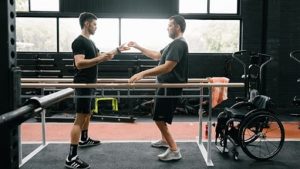Hereditary Spastic Paraplegia (HSP) refers to a group of inherited disorders characterised by a progressive weakness and stiffness in the legs.
In the early stages of the disease, there may be mild gait changes, characterised by stiffness and increased difficulty to keep a hip width base of support. The symptoms slowly progress so that eventually the use of a wheelchair or walker may be required.
The diagnosis of HSP is primarily by a neurological examination to rule out any other disorders. Several genetic mutations have been noted which underline various types of HSP, and specialised genetic testing are diagnosis are available in some medical centres.
Not all children in a family will necessarily develop symptoms, although they may be carriers of the abnormal gene. Symptoms may begin in childhood or adulthood, depending on the particular HSP gene involved.
It’s difficult to know exactly how many people have HSP as it’s often misdiagnosed. It’s Estimated to range between 1 in 11,000 people to 1 in 77,000 people, which is quite a large discrepancy. Around 90% of people with hereditary spastic paraplegia have what’s known as a “pure form” of the condition. This means their symptoms are mainly confined to lower limb weakness and involuntary spasms and muscle stiffness (spasticity). The remaining 10% have a complicated or complex form of the condition (meaning they have other symptoms in addition to the muscle weakness and spasticity).
Treatment: there is no specific treatment to prevent, slow or reverse HSP but you can treat the symptoms, such as muscle relaxants for stiffness in the legs. Physical therapy is also very important to improve function and muscle strength, as well as assisting in maintaining motor control. With an individualised exercise prescription, individuals who suffer from HSP can have a specific program designed to meet their needs and assist with their capabilities. Increasing and retaining strength is vitally important as this will support joints, improve balance, and make activities of daily life easier. Exercise can also assist in helping maintain function and reduce falls risks associated with HSP, as well as improving self esteem and self confidence.
Benefits of Strength training for HSP.
Strengthening exercises help increase muscle tone and improve the quality of muscles. This enhances mobility and provides energy and a positive sense of well-being, as well as helping manage the rigidity within the limbs.
Strong hip and leg muscles are needed to lift the legs to walk and will help create a safer gait. Strong abdominal and back muscles will help maintain correct posture and can counter pain resulting from poor gait, poor posture, or the use of mobility aids.
Knowing which muscles need to be strengthened and how to perform the exercise without over-stressing the joints is important. An exercise physiologist can provide appropriate recommendations and ensure that the exercise you’re doing is most suitable to your needs and goals.




